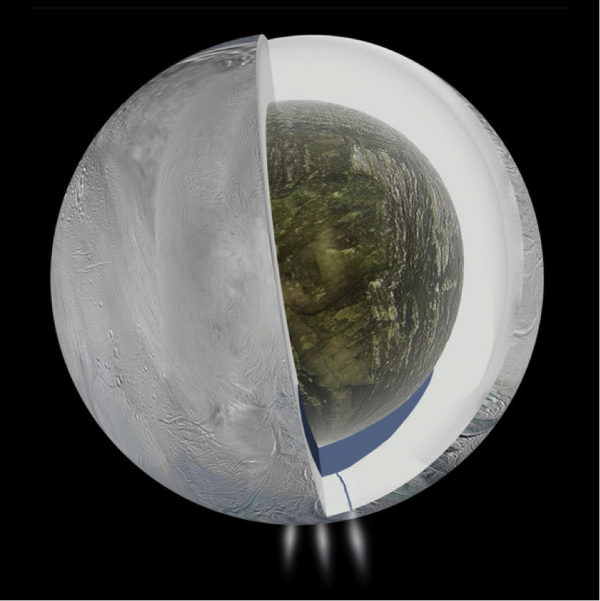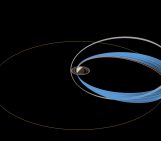This year marks the 10th anniversary of the Cassini-Huygens mission to study Saturn and its moons. But what’s 10 years to us is only a fraction of the Saturnian calendar – in the decade we’ve been studying Saturn up close, the planet has been through only a third of its annual cycle.
In that short time though, scientists have made a multitude of amazing and surprising discoveries about the system – as Athena Coustenis said in a press conference at the EGU General Assembly, “every day this mission brings a new discovery and new data.” A lot of days and a lot of discoveries later, I’ve decided to take on the task of condensing 10 years of splendid science into one post, or at least some of the highlights. If one picture tells a thousand words, the image option should do the trick!

Setting off for Saturn (Credit: NASA)
Back in October 1997, Cassini-Huygens set off for Saturn, lighting up the skies over Cape Canaveral as it began a mission to unravel the mysteries of the Saturnian system. The spacecraft entered the Saturn’s orbit in 2004 and has been beaming back new findings ever since.
The way we see Saturn, with the sun shedding light on its southern hemisphere, gives us the impression of a great golden planet. But Saturn has a hidden face, and in the north, the planet is shrouded in blue – something we didn’t know until Cassini got close:

The two sides of Saturn – the blue north and the golden south (Credit: Cassini Imaging Team/SSI/JPL/ESA/NASA)
Titan, one of Saturn’s moons, has an incredibly thick atmosphere, making it very difficult for us to make out anything of the surface from here. The Cassini-Huygens mission lifted Titan’s veil, first allowing us to see the moon’s surface following the landing of the Huygens probe in 2005, and further through Cassini’s capability to peer through the moon’s thick atmosphere.

How Huygens made it to Titan’s surface. Later analysis of the probe’s accelerometers let scientists suss out how Huygens bounced on landing. (Credit: ESA/D. Ducros)
Other than Earth, Titan is the only body to have liquid lakes on its surface. Unlike our planet though, the moon’s lakes and seas are made up of hydrocarbons (mainly methane and ethane) and almost all of them are in the northern hemisphere. After 9 years of gathering data, scientists working on the Cassini-Huygens mission were able to create a great picture of the moon’s surface and its many water bodies:

Titan’s seas. (Credit: NASA/JPL-Caltech/ASI/USGS)
In 2013, a 2000 kilometre-wide hurricane was spied at the centre of Saturn’s hexagonal jet stream – that’s twice the length of the UK and 20 times larger than the hurricanes we get here on Earth. Earlier on in the mission, Saturn’s north pole was shrouded in darkness, but shifting seasons have shed more light in the north, allowing the probe to capture this image of the hurricane:

Saturn’s super hurricane. This image has been colour-coded to highlight the storm’s altitude: red parts of the image, like the eye of the storm, are at a low altitude and the green-yellow regions are higher up in the atmosphere. (Credit: NASA/JPL-Caltech/SSI)
Last summer the spacecraft put Earth into perspective with its snapshot of our pale blue dot, framed by Saturn’s rings. Images of Earth from the outer Solar System are a rare thing and Cassini’s photo put the total up to three, with people around the world gathering to celebrate the occasion…

Cassini’s pale blue dot – an image emphasising the vastness of the universe. Look a little closer and you can see the Moon too! (Credit: NASA/JPL-Caltech/Space Science Institute)
Earlier this year Cassini gave an intriguing insight into what lies beneath Enceladus’ icy surface. The spacecraft revealed a water mass well over 200 times the size of Lake Garda under the ice, opening up new options in the search for life in the Solar System, which, until now, has been restricted to surface investigations.

The hidden interior of Enceladus. (Credit: NASA/JPL-Caltech)
Finally, and most recently, Cassini has shed light on the wonderful colours of Saturn’s rings, with new images revealing their rainbow nature. The colour variation is due to the different compositions of ice in each ring: the turquoise rings contain almost pure water and the red ones contain more contaminants.

Rainbow rings. (Credit: NASA/JPL/University of Colorado)
With the mission ongoing and set to reach the 2017 solstice, there’s a lot more to come from Cassini-Huygens!
Leading scientists involved in the Cassini-Huygens mission presented some of these findings, as well as some of the latest during the EGU General Assembly. Catch up on some of the more recent results in the Cassini press conference webstream.



